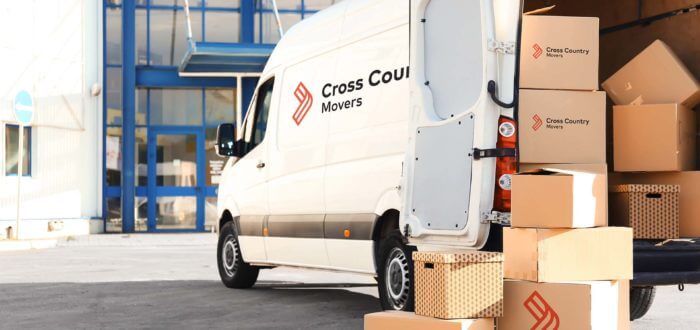

Mastering Your Successful Long-Distance Move – A Step-by-Step Journey
Posted in Moving Essentials,Planning the Move on January 15, 2024
Diving into a successful long-distance move, it’s important to turn what might seem like a mountain of stress into a molehill of efficiency! We’re not just talking about a cross-country move, we’re talking about a thrilling adventure. Packed with practical tips and focused on ensuring a smooth transition, our approach makes relocating feel like a breeze. Prepare to master the art of moving with ease and excitement.
How can you master a successful cross-country move? Start by creating a comprehensive checklist that spans from the early stages of packing to the final day of settling in. Begin decluttering months in advance, donating or selling items you no longer need. This not only lightens the load but can also lighten the stress. Hiring a reputable moving company is crucial for a long-haul move. Ensure they have experience in cross-country relocations and check their reviews for peace of mind. Pack your belongings with care, labeling each box by room and contents. Crucially, keep important documents and essentials in a separate, easily accessible bag.
What Are the Basics of a Long-Distance Move?
A long-distance move, typically defined as relocating over 400 miles or crossing state lines, differs significantly from local moves in complexity and preparation. Unlike shorter relocations, where a quick back-and-forth trip might suffice, long-distance moves require extensive planning and coordination.
A key factor when you plan a long-distance relocation is choosing the right moving company that specializes in long-haul transfers. This is essential for ensuring the safety and security of your belongings. Knowing insurance options to protect your items during transit is also crucial.
Timing is another critical aspect. Long-distance moves often necessitate more flexible scheduling due to the greater distances and logistics involved.
It’s important to meticulously plan every step to relocate safely, from packing strategies that suit prolonged transport to setting up utilities and services in the new home.
Step 1 – Initial Planning and Budgeting
The cornerstone of a successful long-distance move is early planning and meticulous budgeting. Utilizing a moving budget planner can help you anticipate all potential costs, including packing supplies, relocation company fees, insurance, and travel expenses. This proactive approach allows you to allocate funds appropriately and ensures there’s no anxiety about moving out.
List all possible expenses and research average costs in your area. Remember, the sooner you begin this process, the more time you have to adjust the budget and plan, avoiding last-minute financial surprises. Early planning also opens up opportunities for booking long-distance movers at a lower cost and preparing for any unexpected expenses that might arise during the relocation.
How to Create a Realistic Budget
Begin by getting quotes from several affordable movers to compare prices and long-distance moving services. Be wary of extremely low quotes as they might indicate hidden fees or lack of essential services. Factor in additional costs such as packing materials and potential storage fees.
To save on moving costs, consider decluttering your home to reduce the volume of items being moved, and opt for relocating during off-peak seasons when rates are generally lower. Avoid common relocation mistakes like last-minute booking or underestimating packing supplies, as these can lead to unexpected expenses.
How to Choose the Perfect Moving Date
Choosing the perfect moving date is critical in organizing an efficient relocation. The ideal relocation day should be determined by several factors, including work schedules, housing arrangements, and, importantly, the chosen moving company’s availability.
It’s best to consult with the professional moving company you’ve selected, as they can offer insights into the most cost-effective and convenient times to relocate. Typically, avoiding weekends, holidays, and peak relocation seasons can lead to potentially lower costs. Also, take into account external factors like weather conditions and school schedules if you have children.

Step 2 – Selecting a Reliable Moving Company
When it comes to hiring cross-country movers, conducting thorough research is vital to ensure a smooth transition. Start by seeking recommendations and reading online reviews to gauge past customer experiences.
Check whether the company is legitimate by verifying its licensing and insurance status, and consulting the Better Business Bureau website can provide valuable insights into a company’s reputation and history of customer service. Inquire about moving insurance options to protect belongings during transport. A reliable company should be transparent about its policies, pricing, and the range of services it offers – and Cross Country Movers tick all those boxes.
Decide to Use Different Offered Services
Investing in cross-country moving services from professionals can significantly streamline the entire transition process. These services often include auto transport, loading, transportation, and unloading of belongings, as well as packing services.
Each service caters to different needs – auto transport services are essential for safely transporting vehicles over long distances, while packing services ensure that all items are properly protected throughout the journey.
For those who prefer not to handle the organization of belongings themselves, professional services offer a convenient and efficient solution. Comparing the DIY approach to professional services, the latter typically guarantees a higher level of efficiency and security, albeit at a higher cost.

Step 3 – Organize and Declutter Belongings Before the Relocation
Downsizing for a move is a crucial step in this process. Not only does this simplify what needs to be secured for transport, but it also reduces the volume, potentially lowering transport costs. Begin by sorting through all items and categorizing them based on necessity, sentimental value, and practicality. Items that haven’t been used for a long time or are no longer needed can be sold, donated, or recycled.
This is also an excellent opportunity to digitize documents and photographs to reduce physical bulk. The goal is to pack efficiently, keeping only what is essential or holds significant value. This not only eases the transition but also paves the way for a fresh start in the new location.
Effective Tips for Inventory Management
Creating a detailed inventory list is essential for the effective management of belongings during a long-distance relocation. This list helps in deciding what to keep as well as what to get rid of, ensuring that only necessary items are secured for transport. Here’s how to approach this:
- Categorize items – Group belongings by room or type for easier management.
- Assess value – Determine the value of each item, both in terms of cost and sentimental worth.
- Frequency of use – Consider how often items are used. Those rarely used can be candidates for sale or donation.
- Size and weight – Larger, heavier items may be more costly to transport.
This process simplifies decisions about what to keep and what to get rid of, ensuring a more organized approach. For items chosen for transport, use moving and packing services for more efficient and secure handling.
Basic Packing Tips for All Essentials
The easiest way to pack for a relocation involves a mix of organization, careful wrapping, and labeling. By using key expect packing tips, you ensure the belongings arrive in the new location in good condition. The best advice we can give you are tips below:
- Start early – Begin securing belongings well before the relocation day.
- Use quality materials – Invest in sturdy boxes, bubble wrap, and packing tape.
- Label clearly – Mark each box with its contents and intended room.
- Pack room-by-room – Tackle one area at a time for better organization.
- Heavy items in small boxes – This makes them easier to carry.
- Essentials box – Keep a box of daily necessities easily accessible.

Step 4 – Figure Out the Logistics of Moving Day
The success of the relocation day largely depends on how well one prepares for the logistics. This involves creating a detailed timeline, including when professional movers are expected to arrive, how long the loading process might take, and the schedule for the journey to the new location.
Preparing for movers means ensuring all belongings are ready and accessible, making their job more efficient. A moving day checklist is indispensable. It should include last-minute checks like ensuring all items are accounted for, appliances are unplugged, and nothing is left behind in closets or drawers.
Additionally, this is the time to say goodbye to friends and neighbors, adding a personal closure to the transition. Keeping the day organized and sticking to the schedule helps minimize the chaos and stress often associated with relocation.
Take Into Account Safety Measures and Have a Contingency Plan
When planning the relocation day, incorporating safety measures and having a contingency plan are crucial. For moving day safety, ensure clear pathways for transporters to prevent accidents, keep an emergency kit accessible, and be aware of weather conditions that might affect the transition.
It’s also essential to protect valuable items. Consider transporting them separately or using specialized services. As for a contingency plan, it should include alternative routes in case of unexpected travel issues, additional contact numbers for emergency services, and a backup plan for accommodation if the transition takes longer than expected.

Step 5 – Settle Into the Cozy New Home
Once the long journey concludes, settling into a new city marks the beginning of an exciting chapter. The unpacking process and post-move organization play a crucial role in making the new space feel like home.
Unpack essentials and gradually move to less critical items. It’s helpful to tackle one room at a time, beginning with areas like the bedroom and kitchen, to quickly establish a sense of normalcy. Labeling boxes during the packing phase pays off now, as it streamlines locating items.
As you unpack, take the opportunity to reassess the placement of belongings, optimizing the space for comfort and functionality. Meanwhile, adjusting to a new environment involves exploring the neighborhood, connecting with local communities, and incorporating local routines into your daily life.
A Successful Long-Distance Move Is Possible With Cross-Country Movers
A successful long-distance move is not only possible, but it can be a smooth and well-organized experience with the right preparation and support. From initial planning and budgeting to selecting a reliable moving company, each step is crucial in ensuring a seamless transition.
Organizing and decluttering belongings, managing logistics on moving day, and finally settling into a new home are all integral parts of the journey. Safety measures and contingency plans add an extra layer of security and peace of mind. Remember, moving cross country doesn’t have to be a difficult task.
By following these comprehensive tips and seeking professional assistance, you can navigate this significant life change with ease and confidence. For expert guidance and support in your relocation, don’t hesitate to contact Cross Country Movers.
What Is the Best Way to Budget for a Long-Distance Move?
Start by estimating costs for transport services, securing belongings, travel, and accommodation. Utilize a budget planner and research average costs for these services. Factor in unexpected expenses for a comprehensive financial plan.
How Far in Advance Should I Plan My Long-Distance Relocation?
Ideally, this process should begin several months in advance. This allows ample time for researching transport services, organizing belongings, and addressing logistical details.
How Do I Choose a Reputable Relocation Company?
Research various companies read customer reviews, and verify their credentials and insurance policies. Consult the Better Business Bureau and other consumer advocacy groups for additional insight.
What Are the Essential Items to Keep With Me During the Relocation?
Keep important documents, valuables, basic toiletries, a change of clothes, essential electronic devices, and any necessary medications easily accessible.
How Do I Handle Moving Across Country With Pets or Children?
Ensure pets have appropriate carriers and are familiar with them beforehand. For children, keep comforting items and entertainment handy. Plan for regular stops and keep routines as normal as possible.
What Are the Common Challenges During a Long-Distance Relocation?
These include managing logistics, ensuring the safety of belongings, adjusting to new environments, and dealing with emotional stress. Effective planning and organization can mitigate these challenges.
How Can I Ensure the Safety of My Belongings?
Opt for insurance coverage from the transport company. Use quality materials for securing items and consider professional services for large, valuable, or delicate items.
What Should I Do Immediately Upon Arriving at My New Home?
Conduct an initial inspection of the property, ensure utilities are functioning, and begin the organization process. Unpack essential items first to establish comfort.
How Do I Adjust to a New City After a Long-Distance Relocation?
Explore the neighborhood, connect with local communities or social groups, and gradually establish new routines. This helps in acclimating to the new environment and building a sense of belonging.









